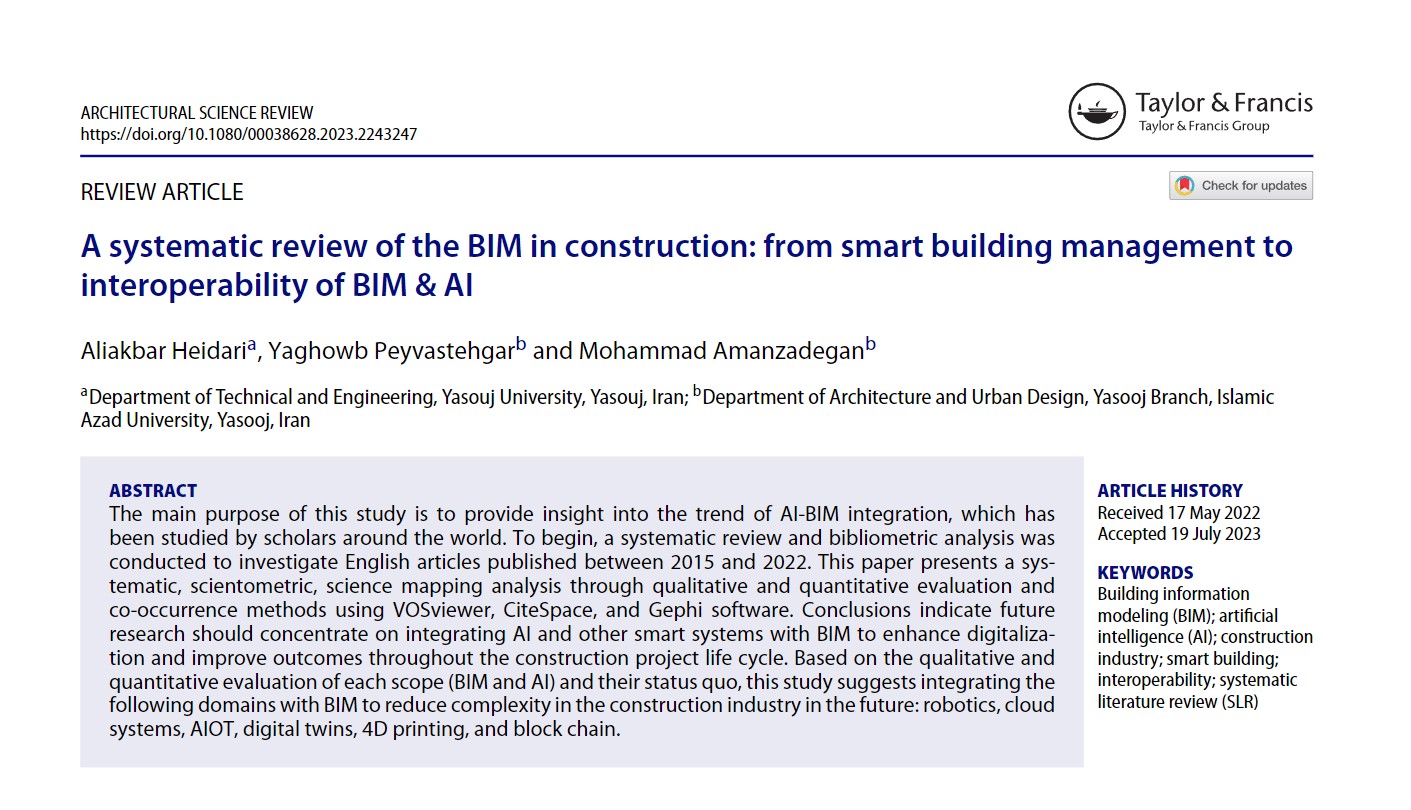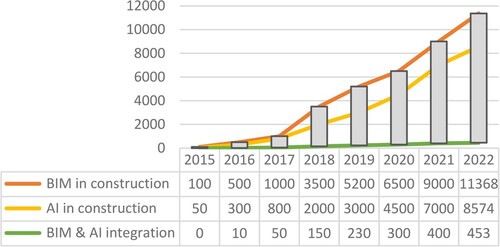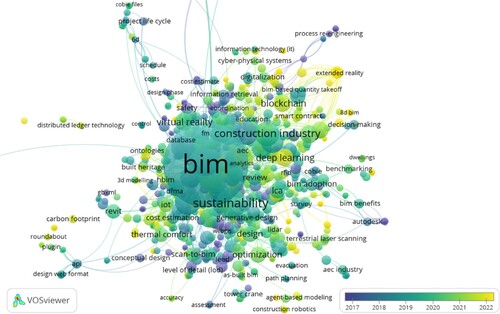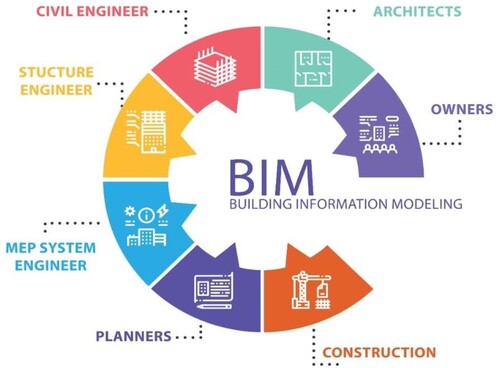
From smart building management to interoperability of BIM & AI | A systematic review of the BIM in construction
Mohammad Amanzadegan Article “A systematic review of the BIM in construction: from smart building management to interoperability of BIM & AI”
In this article
- 1. Introduction
- 2. Review methodology
- 3. Current status quo of BIM and AI
- 4. Interoperability of BIM and AI
- 5. Future research trends and insights
- 6. Conclusions
- Disclosure statement
- References
- Appendixes
Abstract
The main purpose of this study is to provide insight into the trend of AI-BIM integration, which has been studied by scholars around the world. To begin, a systematic review and bibliometric analysis was conducted to investigate English articles published between 2015 and 2022. This paper presents a systematic, scientometric, science mapping analysis through qualitative and quantitative evaluation and co-occurrence methods using VOSviewer, CiteSpace, and Gephi software. Conclusions indicate future research should concentrate on integrating AI and other smart systems with BIM to enhance digitalization and improve outcomes throughout the construction project life cycle. Based on the qualitative and quantitative evaluation of each scope (BIM and AI) and their status quo, this study suggests integrating the following domains with BIM to reduce complexity in the construction industry in the future: robotics, cloud systems, AIOT, digital twins, 4D printing, and block chain.
KEYWORDS:
- Building information modeling (BIM)
- artificial intelligence (AI)
- construction industry
- smart building
- interoperability
- systematic literature review (SLR)
1. Introduction
Development of the construction industry and technology in the building sector is the main manifestation of progress in human societies, population growth, and improvement in living standards (Begić and Galić Citation2021). Building projects face problems such as incidents on building sites, weak planning, insufficient schedules, and lack of cooperation. High energy consumption, rising material costs, waste management, high risk, low productivity, and environmental issues pose challenges to the Architecture Engineering-Construction (AEC) industry worldwide, threatening Our Planet’s Existence (Anumba et al. Citation2021).
According to sustainable development, the issue of ‘Smart Construction’ should be taken into account to meet the needs of future generations and mitigate existing challenges through construction policies and intelligent approaches (Abuimara et al. Citation2021). Regarding these issues, a decision-making environment is required in the Architecture, Engineering, Construction, Operation, and Facility Management (AECO/FM) industry (Mashayekhi and Heravi Citation2020). Despite policies and legislation passed by the United States of America, the European Union, and Australia to reduce building energy consumption, they may not be enough to meet the challenges. Building performances often differ from initial plans, designs, and approvals, necessitating Comprehensive Tools and Platforms to address these challenges (Ferrando et al. Citation2020).
‘Building Information Modeling (BIM)’ has emerged as a simulation tool for managing building construction, facilities, the built environment, and life cycle, predicting building energy use, overcoming obstacles, and facilitating smart building design (Durdyev et al. Citation2022). The first development of BIM in architecture, engineering, and housing, encompassing automation systems, productivity, and renewable and sustainable energy, can be traced back to the 2000s (Li, Afsari, et al. Citation2020). BIM has since been recognized as an important parameter in construction progression. Additionally, BIM is characterized as the ‘’advanced portrayal of the physical and functional qualities of a building’’ (Al-Ashmori et al. Citation2020; Bui, Merschbrock, and Munkvold Citation2016). BIM is a platform that uses diverse design perceptions and methods employing computer-assisted technologies in the construction industry (Li et al. Citation2021). BIM, also known as N-D modeling and virtual prototyping innovation, (N-D model is an extension of the Building Information Model that incorporates multi-aspects of design information required at each stage of the lifecycle of a building facility, including scheduling, costing, accessibility, crime, sustainability, maintainability, acoustics, and energy simulation). BIM, as an inevitable requirement of construction projects, has become more widely accepted in the building industry due to its great efficiency in cost and time reduction (Othman et al. Citation2020). However, to obtain precise outcomes, the BIM platform has to be integrated with new Virtual Reality (VR) technologies like Artificial Intelligence (AI), Machine Learning (ML), the Internet of Things (IoT), and three-dimensional technologies to provide thorough construction requirements and solutions for building smart optimization (Altohami et al. Citation2021).
The term Artificial Intelligence (AI), as a branch of computer science, was first presented during the Dartmouth conference organized by researchers with a keen interest in machine intelligence (McCarthy and Hayes Citation1969). AI acts as the backbone that changes the method of performance in construction projects. AI aims to accept and use the same logic, learning and cognition capacities, reasoning, problem-solving, planning, and data storage capabilities as human beings. AI is a key technology field that assists everyday social life and activities and is driven by the progress of Information and Communication Technology (ICT) and Robotic Technology (RT) (Pan and Zhang Citation2021). Artificial intelligence (AI) can understand its environment and act to achieve objectives logically. It develops in a predictable sequence and achieves its goals through analytical and intuitive actions. The desire for AI research and investment in AI has rapidly increased since the mid-twentieth century as it has provided solutions and addressed various engineering and scientific challenges in an intentional, intelligent, and adaptive manner (Abioye Sofiat et al. Citation2021). AI systems’ performance in immersive learning phases can be used to classify large databases and visualize, explain, and interpret their models. The analysis of probable scientific data, machine learning, cognitive science, and data theory provides access to the area of problem explanation and interpretation, enabling automatic programming, optimization, information compression, and modeling (Rao et al. Citation2021). Machine learning in AI exclusively plays a major role in learning sufficiently strong data from numerous sources and then making an intelligently adaptive decision using insights from structured and unstructured data (Erharter and Marcher Citation2021).
While a significant amount of engineering information is generated in construction projects, the application of AI technologies in building management lags behind. Therefore, there is a growing interest in applying various AI techniques in the construction and building sector to achieve optimal results (Na et al. Citation2022).
The development of construction procedures for reducing building resources through efficient planning and environmentally conscious facilities is employed for mapping, site analysis, technical drawings, and design plans. Moreover, AI has been used for controlling functions, selecting the best options, optimizing processes and outcomes, and automating systems and equipment (Sacks, Girolami, and Brilakis Citation2020).
The construction industry, which has undergone a fundamental revision through BIM, has had the opportunity to integrate new creative solutions using AI. Integration of AI methods into the BIM platform could benefit the construction sector by improving planning, construction, maintenance, and operation through digitalization (Huang, NiniÄ, and Zhang Citation2021).
2. Review methodology
In this study, a systematic literature review was conducted to summarize and assess available technologies in particular research domains, aiming to identify the research trends concerning BIM, AI, and their integration as smart techniques within the construction industry. So far, some studies have used this method to explore the research areas of BIM and AI. The SLR method was carried out in this study to not only identify research questions by gathering, analyzing, and interpreting existing academic articles via science mapping and bibliometric analysis but also to justify the necessity of further studies in these areas. Therefore, ‘keyword co-occurrence’, ‘co-authorship relations’, and ‘citation relations’ were common methods in scientometric surveys (science mapping) and analysis in this study through bibliometric and qualitative analysis. These analyzes provide a general view of the current status of BIM and AI and grounded theory.
This study is the first stage of a larger research project aiming at using BIM and AI for construction in order to reduce the construction challenges and risks of the current generating methods. To be able to define the research focus, initially, current studies in BIM and construction and their characteristics were investigated. Then, AI and construction were explored to examine how AI can contribute to the construction. In addition, the related works with regard to BIM and AI integration were studied to examine the current solutions and to identify existing limitations.
Generally, an SLR systematically gathers previous research papers using a search engine and selects relevant papers based on inclusion and exclusion criteria to answer research questions. Therefore, to guide the SLR process, the following five research questions were formulated:
RQ1. What is the research trend on BIM in construction projects?
RQ2. What is the research trend on AI techniques in construction projects?
RQ3. What are the paradigms and technologies associated with BIM and AI integration?
RQ4. what are the technical methods to integrate BIM and AI?
RQ5. What is the construction industry’s future research directions, trends, and insights?
The SLR process is divided into the following five stages, which are elaborated on throughout the article:
Programming and defining stage
Organizing stage
Categorizing stage
Describing and giving report stage
You can read full article from Taylor & Francis Online
Other Section of this article:
2.1. Programming and defining stage
2.2. Organizing stage

2.3. Categorizing stage
2.4. Describing and giving report stage
3. Current status quo of BIM and AI
3.1. Bibliometric analysis
3.2. Keywords co-occurrence analysis
3.2.1. BIM and construction

3.2.1.1. BIM is more than just software or technology

3.2.2. AI and Construction
3.2.3. BIM and AI
3.3. Co-authorship relations
3.4. Co-citation analysis
4. Interoperability of BIM and AI
4.1. Paradigms and technologies associated with BIM & AI
5. Future research trends and insights
6. Conclusions
Based on the systematic review of the current state of BIM and AI in the construction industry, it is evident that integrating these two technologies has the potential to bring significant benefits, such as improved decision-making, process optimization, and increased efficiency. The construction industry faces various challenges such as low productivity, cost overruns, and unskilled labor forces, and digital fabrication, smart devices, and automation are seen as potential solutions to these issues. Although integrating BIM and AI is challenging, it could be a significant paradigm shift in the construction industry.
The study evaluated over 19,742 research papers between 2015 and 2022 using scientometric and bibliometric analysis. Qualitative analyzes were conducted to evaluate BIM and AI domains using the co-occurrence method, science mapping, and network visualization. The SLR was conducted in five stages: programming, organizing, categorizing, describing, and reporting, and both quantitative and qualitative analyzes were considered using VOSviewer, CiteSpace, and Gephi software.
The analysis indicates that there are various smart devices that can be integrated with BIM, and one type of smart device alone cannot solve the challenges faced by the construction industry. Integrating AI or ML with BIM could be a great chance to level up the construction industry and building lifecycle and solve the limitations of BIM software.
Machine learning has become far more efficient and widely accessible, and in the construction domain, AI has a transformative effect compared with traditional and multi-purpose techniques. The bottleneck now is in architecture and building construction, competitive advantage, innovation, implementation, and the building’s future imagination.
Integrating BIM and AI requires careful consideration of various factors, such as data integration, software compatibility, and project objectives. AI can be integrated into BIM through the use of machine learning algorithms. Machine learning algorithms use statistical techniques to enable the computer system to learn from data, identify patterns, and make predictions. In BIM, machine learning algorithms can be used to predict the performance of building systems, identify potential design issues, and optimize building performance.
Overall, integrating BIM and AI can provide numerous benefits for the construction industry, including improved decision-making, increased efficiency, and enhanced building performance. By standardizing data, using machine learning algorithms, implementing natural language processing, using virtual assistants, utilizing optimization algorithms, and leveraging cloud computing, the integration of BIM and AI can transform the construction industry and lead to significant advancements in building design and construction.
The study highlights the need for further research on the interoperability of BIM and AI and their potential benefits, such as energy consumption, time and cost estimation, long-term vision, and integration of data using BIM. It is evident that AI and machine learning should be integrated into BIM for building and construction estimation purposes. The paper provides insights into future research trends and their interoperability with digital devices and can serve as a guide for researchers and practitioners in the construction industry.
At first glance, the idea that AI and machine learning could and should be integrated into BIM for building and construction estimation purposes may seem almost far-fetched. In order to establish the link from the upstream to downstream of the theoretical background of this research, the relevant drivers of BIM and AI and their mutual interactions, such as applications, types, and usages, were briefly reviewed as the state of the art.
You can read full article from Taylor & Francis Online
To cite this article:
- For EndNote, ProCite, RefWorks, Zotero and most other reference management softwareTY – JOUR
T1 – A systematic review of the BIM in construction: from smart building management to interoperability of BIM & AI
AU – Heidari, Aliakbar
AU – Peyvastehgar, Yaghowb
AU – Amanzadegan, Mohammad
Y1 –
PY –
N1 – doi: 10.1080/00038628.2023.2243247
DO – 10.1080/00038628.2023.2243247
T2 – Architectural Science Review
JF – Architectural Science Review
JO – Architectural Science Review
SP – 1
EP – 18
PB – Taylor & Francis
SN – 0003-8628
M3 – doi: 10.1080/00038628.2023.2243247
UR – https://doi.org/10.1080/00038628.2023.2243247
ER –


